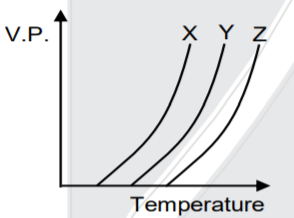What is intermolecular force of attraction ? Mention two types of intermolecular force of attraction acting between molecules.
Step-by-Step Solution:
1. Definition of Intermolecular Force of Attraction:
Intermolecular force of attraction refers to the forces that act between molecules. These forces determine how molecules interact with each other and influence the physical properties of substances.
2. Understanding the States of Matter:
- In solids, molecules are closely packed together, and the intermolecular forces are strong, leading to a definite shape and volume.
- In liquids, molecules are still close but can move past each other, resulting in moderate intermolecular forces. Liquids have a definite volume but take the shape of their container.
- In gases, molecules are far apart and move freely, resulting in weak intermolecular forces. Gases have neither a definite shape nor a definite volume.
3. Types of Intermolecular Forces:
- Cohesive Forces: These are the forces of attraction between similar molecules. For example, the attraction between water molecules in a glass of water is a cohesive force.
- Adhesive Forces: These are the forces of attraction between dissimilar molecules. An example is the attraction between water molecules and the molecules of the glass container.
4. Conclusion:
Intermolecular forces of attraction play a crucial role in determining the properties of different states of matter and can be categorized mainly into cohesive and adhesive forces.
---
Intermolecular force of attraction refers to the forces that act between molecules. These forces determine how molecules interact with each other and influence the physical properties of substances.
- In solids, molecules are closely packed together, and the intermolecular forces are strong, leading to a definite shape and volume.
- In liquids, molecules are still close but can move past each other, resulting in moderate intermolecular forces. Liquids have a definite volume but take the shape of their container.
- In gases, molecules are far apart and move freely, resulting in weak intermolecular forces. Gases have neither a definite shape nor a definite volume.
- Cohesive Forces: These are the forces of attraction between similar molecules. For example, the attraction between water molecules in a glass of water is a cohesive force.
- Adhesive Forces: These are the forces of attraction between dissimilar molecules. An example is the attraction between water molecules and the molecules of the glass container.
Intermolecular forces of attraction play a crucial role in determining the properties of different states of matter and can be categorized mainly into cohesive and adhesive forces.
Topper's Solved these Questions
- BOOK - PEARSON IIT JEE FOUNDATIONCHAPTER - CLASSIFICATION OF MATTEREXERCISE - ESSAY TYPE QUESTIONS8videos
CLASSIFICATION OF MATTER
- BOOK - PEARSON IIT JEE FOUNDATIONCHAPTER - CLASSIFICATION OF MATTEREXERCISE - CONCEPT APPLICATION LEVEL-110videos
CLASSIFICATION OF MATTER
- BOOK - PEARSON IIT JEE FOUNDATIONCHAPTER - CLASSIFICATION OF MATTEREXERCISE - VERY SHORT-ANSWER TYPE QUESTIONS20videos
CLASSIFICATION OF MATTER
- BOOK - PEARSON IIT JEE FOUNDATIONCHAPTER - CLASSIFICATION OF MATTEREXERCISE - ASSESSMENT TEST (TEST-2)9videos
CLASSIFICATION OF MATTER
- BOOK - PEARSON IIT JEE FOUNDATIONCHAPTER - MOCK TESTEXERCISE - EXERCISE25videos
MOCK TEST
Similar Questions
Knowledge Check
- Question 1 - Select One
Intermolecular forces of attraction are more in
AFluorineBIodineCBromineDChlorine - Question 2 - Select One
Which of the following is intermolecular force of attraction?
AIonic bondBcovalent bondCmetallic bondingDdipole-dipole - Question 3 - Select One
Attractive intermolecular forces are known as
Acentrifugal forcesBvander waal's forcesCnuclear forcesDmechanical forces
Which state of matter has least intermolecular forces of attraction?
View SolutionHow are polymers classified on the basis of intermolecular forces of attraction ?
View SolutionWhat type of intermolecular force leads to high density polymer?
View SolutionWeak Forces (Intermolecular Forces)
View SolutionAttractive intermolecular forces are known as
View Solution


 '
'